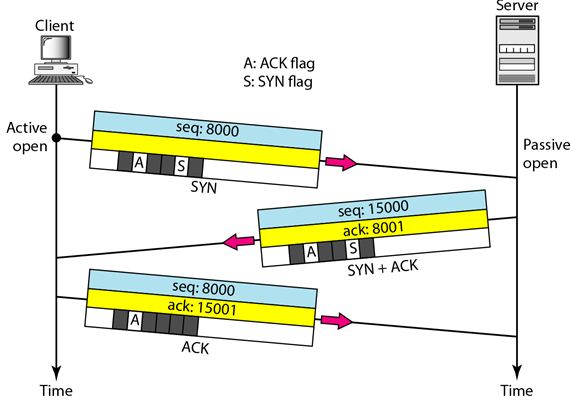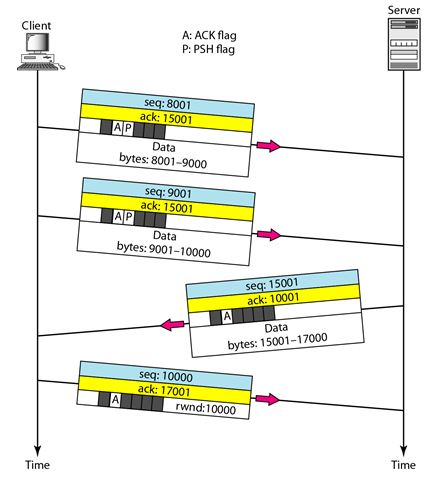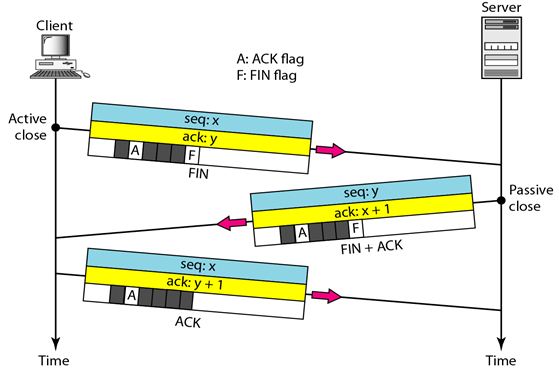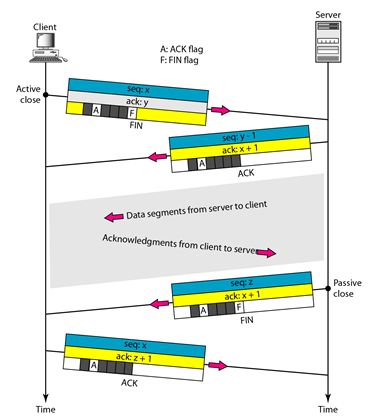How To Create a TCP Connection?
TCP is connection-oriented. A connection-oriented transport protocol establishes a virtual path between the source and destination. All the segments belonging to a message are then sent over this virtual path. Using a single virtual pathway for the entire message facilitates the acknowledgment process as well as retransmission of damaged or lost frames.
In TCP, connection-oriented transmission requires three phases:
1. Connection establishment
2. Data transfer
3. Connection termination.
Connection Establishment:
TCP transmits data in full-duplex mode. When two TCPs in two machines are connected, they are able to send segments to each other simultaneously. This implies that each party must initialize communication and get approval from the other party before any data are transferred.
Process-to-Process Delivery Concepts
User Datagram Protocol (UDP)
TCP services
TCP Segment
Three-Way Handshaking:
The connection establishment in TCP is called three way handshaking. In our example, an application program, called the client, wants to make a connection with another application program, called the server, using TCP as the transport layer protocol.
The process starts with the server. The server program tells its TCP that it is ready to accept a connection. This is called a request for a passive open. Although the server TCP is ready to accept any connection from any machine in the world, it cannot make the connection itself.
The client program issues a request for an active open. A client that wishes to connect to an open server tells its TCP that it needs to be connected to that particular server. TCP can now start the three-way handshaking process as shown in the following figure.
To show the process, we use two time lines, one at each site. Each segment has values for all its header fields and perhaps for some of its option fields, too.
We show the sequence number, the acknowledgment number, the control flags (only those that are set), and the window size, if not empty. The three steps in this phase are as follows.
1. The client sends the first segment, a SYN segment, in which only the SYN flag is set. This segment is for synchronization of sequence numbers. It consumes one sequence number. When the data transfer starts, the sequence number is incremented by 1. We can say that the SYN segment carries no real data, but we can think of it as containing 1 imaginary byte.
2. The server sends the second segment, a SYN +ACK segment, with 2 flag bits set, SYN and ACK. This segment has a dual purpose. It is a SYN segment for communication in the other direction and serves as the acknowledgment for the SYN segment. It consumes one sequence number.
3. The client sends the third segment. This is just an ACK segment. It acknowledges the receipt of the second segment with the ACK flag and acknowledgment number field. Note that the sequence number in this segment is the same as the one in the SYN segment; the ACK segment does not consume any sequence numbers.
SYN Flooding Attack:
The connection establishment procedure in TCP is susceptible to a serious security problem called the SYN flooding attack. This happens when a malicious attacker sends a large number of SYN segments to a server, pretending that each of them is corning from a different client by faking the source IP addresses in the datagrams.
The server, assuming that the clients are issuing an active open, allocates the necessary resources, such as creating communication tables and setting timers. The TCP server then sends the SYN +ACK segments to the fake clients, which are lost.
During this time, however, a lot of resources are occupied without being used. If, during this short time, the number of SYN segments is large, the server eventually runs out of resources and may crash. This SYN flooding attack belongs to a type of security attack known as a denial-of-service attack.
Some implementations of TCP have strategies to alleviate the effects of a SYN attack. Some have imposed a limit on connection requests during a specified period of time. Others filter out datagrams coming from unwanted source addresses. One recent strategy is to postpone resource allocation until the entire connection is set up, using what is called a cookie.
Data Transfer:
After connection is established, bidirectional data transfer can take place. The client and server can both send data and acknowledgments.
The following figure shows an example of data transfer.
In this example, after connection is established (not shown in the figure), the client sends 2000 bytes of data in two segments. The server then sends 2000 bytes in one segment. The client sends one more segment. The first three segments carry both data and acknowledgment, but the last segment carries only an acknowledgment because there are no more data to be sent. Note the values of the sequence and acknowledgment numbers.
The data segments sent by the client have the PSH (push) flag set so that the server TCP knows to deliver data to the server process as soon as they are received. The segment from the server, on the other hand, does not set the push flag. Most TCP implementations have the option to set or not set this flag.
Pushing Data:
The sending TCP uses a buffer to store the stream of data coming from the sending application program. The sending TCP can select the segment size. The receiving TCP also buffers the data when they arrive and delivers them to the application program when the application program is ready or when it is convenient for the receiving TCP. This type of flexibility increases the efficiency of TCP.
But on some occasions the application program has no need for this flexibility. For example, the application program on one site wants to send a keystroke to the application at the other site and receive an immediate response. Delayed transmission and delayed delivery of data may not be acceptable by the application program.
TCP can handle such a situation. The application program at the sending site can request a push operation. This means that the sending TCP must not wait for the window to be filled. It must create a segment and send it immediately. The sending TCP must also set the push bit (PSH) to let the receiving TCP know that the segment includes data that must be delivered to the receiving application program as soon as possible and not to wait for more data to come.
Urgent Data:
TCP is a stream-oriented protocol. This means that the data are presented from the application program to TCP as a stream of bytes. Each byte of data has a position in the stream. However, on occasion an application program needs to send urgent bytes. This means that the sending application program wants a piece of data to be read out of order by the receiving application program.
The solution is to send a segment with the URG bit set. The sending application program tells the sending TCP that the piece of data is urgent. The sending TCP creates a segment and inserts the urgent data at the beginning of the segment. The rest of the segment can contain normal data from the buffer. The urgent pointer field in the header defines the end of the urgent data and the start of normal data.
When the receiving TCP receives a segment with the URG bit set, it extracts the urgent data from the segment, using the value of the urgent pointer, and delivers them, out of order, to the receiving application program..
Connection Termination:
Any of the two parties involved in exchanging data (client or server) can close the connection, although it is usually initiated by the client. There are two options for connection termination: three-way handshaking and four-way handshaking with a half-close option.
Three-Way Handshaking: The three-way handshaking for connection termination as shown in the following figure.
1. In a normal situation, the client TCP, after receiving a close command from the client process, sends the first segment, a FIN segment in which the FIN flag is set. Note that a FIN segment can include the last chunk of data sent by the client, or it can be just a control segment as shown in the above figure. If it is only a control segment, it consumes only one sequence number.
2. The server TCP, after receiving the FIN segment, informs its process of the situation and sends the second segment, a FIN +ACK segment, to confirm the receipt of the FIN segment from the client and at the same time to announce the closing of the connection in the other direction. This segment can also contain the last chunk of data from the server. If it does not carry data, it consumes only one sequence number.
3. The client TCP sends the last segment, an ACK segment, to confirm the receipt of the FIN segment from the TCP server. This segment contains the acknowledgment number, which is 1 plus the sequence number received in the FIN segment from the server. This segment cannot carry data and consumes no sequence numbers.
Half-Close: In TCP, one end can stop sending data while still receiving data. This is called a half-close. It can occur when the server needs all the data before processing can begin.
A good example is sorting. When the client sends data to the server to be sorted, the server needs to receive all the data before sorting can start. This means the client, after sending all the data, can close the connection in the outbound direction. However, the inbound direction must remain open to receive the sorted data. The server, after receiving the data, still needs time for sorting; its outbound direction must remain open.
The following figure shows an example of a half-close.
The client half-closes the connection by sending a FIN segment. The server accepts the half-close by sending the ACK segment.
The data transfer from the client to the server stops. The server, however, can still send data. When the server has sent all the processed data, it sends a FIN segment, which is acknowledged by an ACK from the client. After half-closing of the connection, data can travel from the server to the client and acknowledgments can travel from the client to the server. The client cannot send any more data to the server.
For Further Reading:
Back to DCN Questions and Answers





